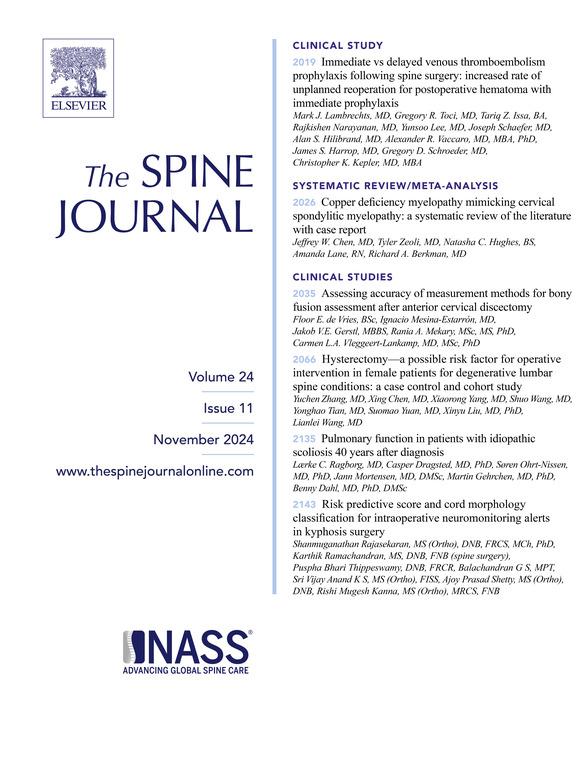16. Beyond smoking: the impact of nontobacco nicotine on lumbar spinal fusion outcomes in a propensity matched analysis
IF 4.7
1区 医学
Q1 CLINICAL NEUROLOGY
引用次数: 0
Abstract
BACKGROUND CONTEXT
Lumbar spinal fusion is a commonly performed procedure for many conditions. Recently, there has been an increased usage of nontobacco nicotine products such as electronic cigarettes and smokeless tobacco alternatives. As such, their impact on spinal fusion outcomes is unknown.
PURPOSE
The purpose of this study was to utilize a large database with a propensity-matched cohort to analyze postoperative outcomes in patients who have non-tobacco nicotine dependence compared to those without nicotine dependence.
STUDY DESIGN/SETTING
This was a large retrospective cohort database analysis utilizing the TriNetX platform.
PATIENT SAMPLE
All patients in the TriNetX platform who underwent lumbar spinal fusion (LSF) with a minimum follow-up of 30 days were included for analysis. Patients were stratified into two groups based on preoperative diagnosis of nicotine dependence, excluding those with tobacco-based dependence.
OUTCOME MEASURES
Outcomes were measured at 90 days and 2 years. Early outcomes that were measured at 90 days included the following medical complications: myocardial infarction (MI), deep venous thrombosis (DVT), pulmonary embolism (PE), pneumonia, acute kidney injury (AKI), and sepsis. Surgical outcomes included wound complications and hardware infection. Hospital outcomes included emergency department (ED) visits and readmission. Risk and hazard ratios were reported with associated p values. At two years, surgical outcomes were studied, which included, mechanical complications, hardware complications, pseudoarthrosis, infection, adjacent segment disease (ASD), and revision surgery.
METHODS
Patients in the TriNetX platform who underwent LSF with a minimum follow-up of 30 days were identified. Patients were then split into two groups, based on their non-tobacco nicotine dependence status identified by ICD-10 Clinical Modification codes, and 1:1 propensity-matched based on sex, age, race, and additional comorbidities. Analysis was performed for the above outcome measures. Analysis was performed for the outcome measures as mentioned.
RESULTS
After propensity score matching, 45,343 patients were identified for each cohort. At 90 days, patients with nontobacco nicotine dependence had a 0.878 times decreased risk of DVT (95% CI 0.818 – 0.943, p < 0.001) and a 0.877 times decreased risk of PE (95% CI 0.801 – 0.959, p = 0.004). Additionally, patients with nontobacco nicotine dependence have a 1.089 times higher risk of a subsequent ED visit within 90 days (95% CI 1.089 – 1.166, p < 0.001). At 2 years, patients with non-tobacco nicotine dependence were at 1.159 times higher risk of mechanical complications (95% CI 1.095 – 1.228, p<0.001) and 1.129 times higher risk of ASD (95% CI 1.084 – 1.176, p<0.001). There was a trend toward increased risk of infection in patients with non-tobacco nicotine dependence, however, this did not reach statistical significance (p=0.093).
CONCLUSIONS
Nontobacco nicotine dependence may pose a risk of long-term complications related to lumbar spinal fusion, including an increased risk of mechanical complications and adjacent segment disease. As such, it may be paramount to counsel patients regarding cessation of nontobacco nicotine products prior to undergoing lumbar spinal fusion. This study highlights potential complications in patients with non-tobacco nicotine dependence undergoing lumbar spinal fusion.
FDA Device/Drug Status
This abstract does not discuss or include any applicable devices or drugs.
16. 吸烟之外:倾向匹配分析中非烟草尼古丁对腰椎融合结果的影响
背景背景腰椎融合术在许多情况下都是一种常见的手术。最近,人们越来越多地使用非烟草尼古丁产品,如电子烟和无烟烟草替代品。因此,它们对脊柱融合结果的影响尚不清楚。目的:本研究的目的是利用一个具有倾向匹配队列的大型数据库,分析非尼古丁依赖患者与非尼古丁依赖患者的术后结局。研究设计/设置:这是一项利用TriNetX平台的大型回顾性队列数据库分析。患者样本:所有在TriNetX平台上接受腰椎融合术(LSF)并至少随访30天的患者被纳入分析。根据术前尼古丁依赖诊断将患者分为两组,排除烟草依赖患者。结果测量在90天和2年时测量结果。在90天测量的早期结果包括以下医学并发症:心肌梗死(MI)、深静脉血栓形成(DVT)、肺栓塞(PE)、肺炎、急性肾损伤(AKI)和败血症。手术结果包括伤口并发症和硬体感染。医院结果包括急诊科(ED)就诊和再入院。报告风险和危险比,并附有相关的p值。两年后,研究手术结果,包括机械并发症、硬件并发症、假关节、感染、邻近节段疾病(ASD)和翻修手术。方法选择TriNetX平台中接受LSF且至少随访30天的患者。然后根据ICD-10临床修改代码确定的非烟草尼古丁依赖状态将患者分为两组,并根据性别、年龄、种族和其他合并症按1:1的倾向匹配。对上述结局指标进行分析。对上述结局指标进行分析。结果倾向评分匹配后,每个队列共确定45,343例患者。在第90天,非烟草尼古丁依赖患者DVT风险降低0.878倍(95% CI 0.818 - 0.943, p < 0.001), PE风险降低0.877倍(95% CI 0.801 - 0.959, p = 0.004)。此外,非烟草尼古丁依赖患者在90天内出现急诊科就诊的风险高出1.089倍(95% CI 1.089 - 1.166, p < 0.001)。2年时,非烟草尼古丁依赖患者发生机械并发症的风险高出1.159倍(95% CI 1.095 - 1.228, p < 0.001),发生ASD的风险高出1.129倍(95% CI 1.084 - 1.176, p < 0.001)。非烟草尼古丁依赖患者有感染风险增加的趋势,但没有达到统计学意义(p=0.093)。结论非烟草尼古丁依赖可能会增加腰椎融合相关的长期并发症,包括机械并发症和邻近节段疾病的风险。因此,建议患者在腰椎融合术前停止使用非烟草尼古丁产品可能是至关重要的。这项研究强调了非烟草尼古丁依赖患者接受腰椎融合术的潜在并发症。FDA器械/药物状态本摘要不讨论或包括任何适用的器械或药物。
本文章由计算机程序翻译,如有差异,请以英文原文为准。
求助全文
约1分钟内获得全文
求助全文
来源期刊

Spine Journal
医学-临床神经学
CiteScore
8.20
自引率
6.70%
发文量
680
审稿时长
13.1 weeks
期刊介绍:
The Spine Journal, the official journal of the North American Spine Society, is an international and multidisciplinary journal that publishes original, peer-reviewed articles on research and treatment related to the spine and spine care, including basic science and clinical investigations. It is a condition of publication that manuscripts submitted to The Spine Journal have not been published, and will not be simultaneously submitted or published elsewhere. The Spine Journal also publishes major reviews of specific topics by acknowledged authorities, technical notes, teaching editorials, and other special features, Letters to the Editor-in-Chief are encouraged.
 求助内容:
求助内容: 应助结果提醒方式:
应助结果提醒方式:


